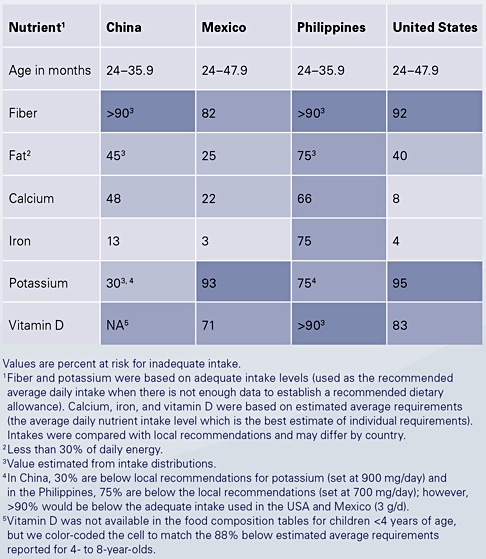Nutritional Landscape and Dietary Patterns in Toddlers
Key Messages
Toddlers and young children should be able to get all the nutrients they need body of knowledge on child diet sium are generally below recommendations in the diets of young children across different countries.
Other nutrient gaps are country-specifc, depending on food availability and local dietary habits.
Dietary intake data are needed to identify appropriate foods and beverages to provide the necessary nutrients
Toddlers and young children should be able to get all the nutrients they need from an adequate and diverse diet. Unfortunately, this is not the case in many countries around the world. Even in countries with an adequate food supply, young children need a variety of nutrient-dense foods and beverages to get the nutrients they need [1].
How do we assess nutrient adequacy in young children? Organizations like the World Health Organization and the World Bank focus primarily on iron, zinc, vitamin A, and iodine in children <5 years of age [2, 3]. While these nutrients are critically important for child development, growth, and health, the deficiency data do not give us a view on the full complement of nutrients available in the diet. Detailed dietary intake data are required to provide a more robust picture of overall food consumption, nutrient intakes, and dietary patterns, and complement these biological endpoints when looking for nutrient gaps or excesses.
Where do comprehensive dietary intake data come from? Many countries conduct national nutrition and health surveys, so they can monitor dietary intakes, nutritional issues, food security, and child growth. Nestlé Research contributes to the body of knowledge on child diet through studies like the Feeding Infants and Toddlers Study (FITS) and Kids Nutrition and Health Study (KNHS) [4], either by analyzing data from national surveys [5, 6] or conducting our own studies when national survey data do not exist [7, 8].
What can we learn about toddler diets from individual country data? Let us take a look at four FITS and KNHS countries as examples: China [8], Mexico [5], the Philippines [6], and the United States [7]. Table 1 compares the percent of young children falling below recommendations for several nutrients of concern, with darker shading showing greater risk for inadequacy. While there are nutrients that are lacking almost universally, like dietary fiber, vitamin D, and potassium, other nutrients of concern differ by country. For example, young children in the US generally consume milk and dairy products and, consequently, few (8.1%) fall below recommendations for calcium [7]. In contrast, 66% of all young children in the Philippines have calcium intakes below recommendations [6], related to low milk and dairy food consumption.

An in-depth view of dietary intake can help to focus education and fortification efforts to target the nutrients of greatest need on a country-by-country basis. In addition, understanding local dietary patterns can help to identify the foods and beverages most relevant to help alleviate these gaps.
References
- Hojsak I, Bronsky J, Campoy C, Domellöf M, Embleton N, Fidler Mis N, et al. Young child formula: a position paper by the ESPGHAN Committee on Nutrition. J Pediatr Gastroen-terol Nutr. 2018 Jan;66(1):177–185.
- The World Bank. Prevalence of Anemia among Children (% of children under 5). 2016 data. World Health Organization, Global Health Observatory Data Repository/World Health Statistics (apps.who.int/gho/data/ node.main.1?lang=en).
- Ritchie H, Roser M. Our World in Data. Micronutrient Defi ciency. 2017. Accessed online at: https://ourworldindata.org/ micronutrient-deficiency.
- Eldridge AL. FITS and KNHS overview: methodological challenges in dietary intake data collection among infants, toddlers, and children in selected countries. Nestle Nutr Inst Workshop Ser. 2019; 91:69–78.
- Villalpando-Carrión S, Eldridge AL. Feeding patterns of infants and toddlers, the Mexico case study. Nestle Nutr Inst Workshop Ser. 2019; 91:89–97.
- Denney L, Angeles-Agdeppa I, Capanzana MV, Toledo MB, Donohue J, Carriquiry A. Nutrient intakes and food sources of Filipino infants, toddlers and young children are inadequate: findings from the National Nutrition Survey 2013. Nutrients. 2018 Nov;10(11):E1730.
- Bailey RL, Catellier DJ, Jun S, Dwyer JT, Jacquier EF, Anater AS, et al. Total usual nutrient intakes of US children (under 48 months): findings from the Feeding Infants and Toddlers Study (FITS) 2016. J Nutr. 2018 Sep;148 (9S):1557S–1566S.
- Chen C, Denney L, Zheng Y, Vinyes-Pares G, Reidy K, Wang H, et al. Nutrient intakes of infants and toddlers from maternal and child care centres in urban areas of China, based on one 24-hour dietary recall. BMC Nutrition. 2015; 1:23.
